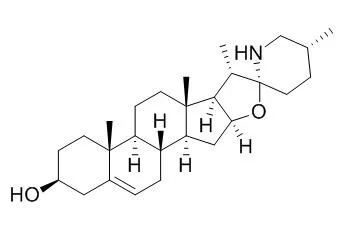| Description: |
Solasodine has anticonvulsant, anti-oxidant, neuroprotection, and central nervous system depressant activities.Solasodine stimulates in situ neurogenesis from resident neuronal progenitors as part of neuron replacement therapy.
|
| Targets: |
SOD | NO | GABA Receptor |
| In vitro: |
| J Chromatogr B Analyt Technol Biomed Life Sci. 2014 Jul 15;963:24-8. | | Development and validation a liquid chromatography mass spectrometry for determination of solasodine in rat plasma and its application to a pharmacokinetic study.[Pubmed: 24922600] | Solasodine is a poisonous alkaloid chemical compound that occurs in plants of the Solanaceae family.
METHODS AND RESULTS:
A simple and selective liquid chromatography mass spectrometry method for determination of Solasodine in rat plasma was developed and validated over the range of 3-1,000 ng/mL. Chromatographic separation was achieved on a C18 (2.1 mm×50 mm, 3.5 μm) column with acetonitrile-0.1% formic acid in water as mobile phase with gradient elution. The flow rate was set at 0.4 mL/min. After addition of midazolam as internal standard (IS), liquid-liquid extraction by ethyl acetate was used as sample preparation. An electrospray ionization source was applied and operated in positive ion mode; selective ion monitoring mode was used for quantification with target ions m/z 414 for Solasodine and m/z 326 for IS. Mean recoveries of Solasodine in rat plasma were in the range of 87.6-94.1%. Matrix effects for Solasodine were between 94.9% and 102.3%. Coefficient of variation of intra-day and inter-day precision were both <13%. The accuracy of the method ranged from 94.4% to 105.3%.
CONCLUSIONS:
The method was successfully applied to a pharmacokinetic study of Solasodine after oral administration of 20mg/kg in rats. | | Interdiscip Sci . 2018 Jun;10(2):297-310. | | Evaluation and Elucidation Studies of Natural Aglycones for Anticancer Potential using Apoptosis-Related Markers: An In silico Study[Pubmed: 27709544] | | Abstract
Exposure to exogenous and endogenous chemicals and subsequent cellular and molecular changes has been linked to enhanced cell proliferation and restricted apoptosis phenomenon. Though in the past decades numerous anticancer drugs inducing programmed cell death in cancer cells by targeting specific apoptotic markers have reached the market, they have been allied with unwanted side effects, ranging from mild to severe toxicity. With further understanding on the functional mechanism of p53 and MDM2 in apoptosis and in our continuous search for new and potent multi-target anticancer lead compounds, we have carried out molecular docking and inhibition studies of the selected aglycones along with selected anticancer leads, against the specific apoptotic and cell cycle markers using AutoDock Tools 4.0 and other computational softwares. The docking results have been analyzed in terms of binding energies (kcal/mol) and inhibition constant (μM). The study clearly proposes our aglycones [solanidine (Solanid-5-en-3β-ol), Solasodine (Solasod-5-en-3β-ol), and tomatidine (5α-Tomatidan-3β-ol)] induce apoptosis by inhibiting the p53-MDM2 complex, p21Waf1/Cip1, and Bcl-2 proteins, which were even found comparable with the anticancer drugs nutlin and/or halofuginone. The work further emphasizes that the individual molecular targets such as BAX and Bcl-2 may result in misleading data at any level; however, ratio of responses to BAX and Bcl-2 shall be considered for better clue about a compound to be pro- or anti-apoptotic.
Keywords: Apoptosis; BAX; BAX/Bcl-2 ratio; Molecular docking; p53–MDM2 complex. |
|
| In vivo: |
| Eur J Pharmacol. 2014 Feb 15;725:40-6. | | Solasodine protects rat brain against ischemia/reperfusion injury through its antioxidant activity.[Pubmed: 24444441] | Ischemic stroke is the second leading cause of death worldwide. The major limitation of stroke management is the lack of clinically effective therapy. Antioxidants have been demonstrated as potent neuroprotective agents by enhancing the defense mechanism(s), whereas reducing the oxidative stress in the ischemic stroke models. In the present study, we evaluated neuroprotective potential of Solasodine, an antioxidant glycoalkaloid of Solanum species, against global model of ischemia in rats.
METHODS AND RESULTS:
Ischemia/reperfusion (I/R)-injury produced marked elevation in lipid peroxidation (LPO) and nitric oxide (NO), whereas superoxide dismutase (SOD), catalase (CAT), and glutathione (GSH) levels were decreased in experimental animals. Prior administration of Solasodine (100 and 200mg/kg, p.o.) significantly heightened SOD, CAT, GSH and total thiols, whereas reduced LPO and NO levels in the brain. Interestingly, brain coronal sectioning and histopathology studies revealed a marked reversal of I/R-provoked neuronal damage in the Solasodine treatment groups.
CONCLUSIONS:
Taken together, our study, for the first time, demonstrates neuroprotective potential of Solasodine against global ischemia-induced cerebral injury in experimental rats. We propose that the neuroprotection offered by Solasodine could be attributed, at least in part, to its anti-oxidant property. |
|






 Cell. 2018 Jan 11;172(1-2):249-261.e12. doi: 10.1016/j.cell.2017.12.019.IF=36.216(2019)
Cell. 2018 Jan 11;172(1-2):249-261.e12. doi: 10.1016/j.cell.2017.12.019.IF=36.216(2019) Cell Metab. 2020 Mar 3;31(3):534-548.e5. doi: 10.1016/j.cmet.2020.01.002.IF=22.415(2019)
Cell Metab. 2020 Mar 3;31(3):534-548.e5. doi: 10.1016/j.cmet.2020.01.002.IF=22.415(2019) Mol Cell. 2017 Nov 16;68(4):673-685.e6. doi: 10.1016/j.molcel.2017.10.022.IF=14.548(2019)
Mol Cell. 2017 Nov 16;68(4):673-685.e6. doi: 10.1016/j.molcel.2017.10.022.IF=14.548(2019)